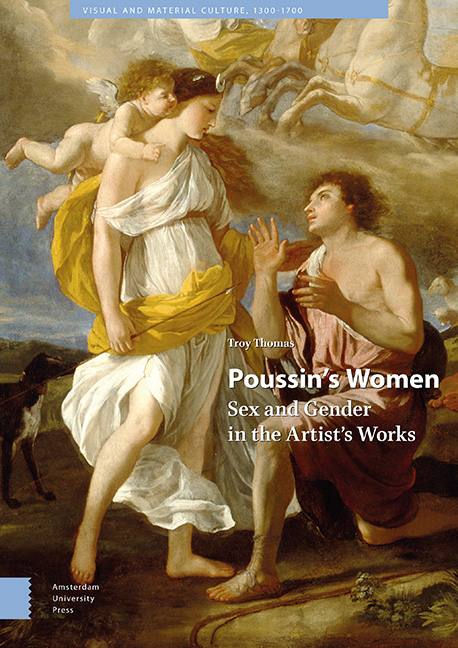Book contents
- Frontmatter
- Contents
- List of Illustrations
- Acknowledgments
- Part I – Violence and Virtue in Poussin’s Representations of Women
- Part II – Poussin’s Women—Cultural and Social Frames
- Part III – Paintings and Drawings
- 1 Predators
- 2 The Lustful—Triumphant, Impulsive, Spying, Conquered
- 3 Lovers—Genuine, Controlling, Unrequited, Jealous
- 4 Killers, Transgressors
- 5 Victims I—Killed, Assaulted
- 6 Victims II—Voiceless, Deceived
- 7 Heroines, Great Ladies
- Conclusion
- Bibliography
- Index
Part II - – Poussin’s Women—Cultural and Social Frames
Published online by Cambridge University Press: 20 November 2020
- Frontmatter
- Contents
- List of Illustrations
- Acknowledgments
- Part I – Violence and Virtue in Poussin’s Representations of Women
- Part II – Poussin’s Women—Cultural and Social Frames
- Part III – Paintings and Drawings
- 1 Predators
- 2 The Lustful—Triumphant, Impulsive, Spying, Conquered
- 3 Lovers—Genuine, Controlling, Unrequited, Jealous
- 4 Killers, Transgressors
- 5 Victims I—Killed, Assaulted
- 6 Victims II—Voiceless, Deceived
- 7 Heroines, Great Ladies
- Conclusion
- Bibliography
- Index
Summary
Abstract
Part II examines Poussin's works from the perspective of attitudes about women in seventeenth-century Italy and France. His ancient and contemporary literary sources are investigated from a gender studies viewpoint, as are his ideas on art. The impact on Poussin of changing views of gender in French theater is analyzed, and the values of his patrons are explored.
Keywords: Women's History—France, Misogyny, Art Theory, Theater, Patronage
Poussin, Ovid, and misogyny
An issue worth considering in the study of Poussin's women centers on the author of important poems that inspired many of his mythological pictures. Is the Roman poetry of Ovid, author of the Metamorphoses (as well as the Fasti and Ars amatoria), a feminist or misogynist? Ovid's critical fortunes with respect to this question are mixed: some have seen his works as proto-feminist, giving voice to women; others, holding the majority opinion, have characterized his literary output as sexist and degrading to women, particularly in his descriptions of them as objects of abusive male sexual desire and rape. For example, it has been said that when Ovid describes the rapes of women in the Metamorphoses, he ‘applied his wit to unfunny circumstances’. Ovid's narrations of sexual encounters have been viewed as pornographic because they convert the women he describes into sexual objects for the delectation of the males within his texts, usually gods, and for the vicarious pleasure of his male readers. One wonders how women, both contemporary with Ovid and in the European Renaissance, received his poetic accounts of rape, since their reading was governed by the patriarchal sign systems that produced and perpetuated his canonical texts. His poetry was designed to take into account the voyeurism and imaginative gaze of his male audience.
This last point may also be made with respect to Poussin's pictures. Because of the historical hierarchy of gender favoring men, Poussin's paintings, like Ovid's literary works, often fail to create a position for his female audience or to concretize what the ‘female gaze’ might require. In the works of both, the female is a site of violence, and in Poussin's paintings, an overriding issue in the construction of gender is often the presentation of dramatic, sometimes destructive, conflict between his protagonists.
- Type
- Chapter
- Information
- Poussin's WomenSex and Gender in the Artist's Works, pp. 53 - 92Publisher: Amsterdam University PressPrint publication year: 2020



